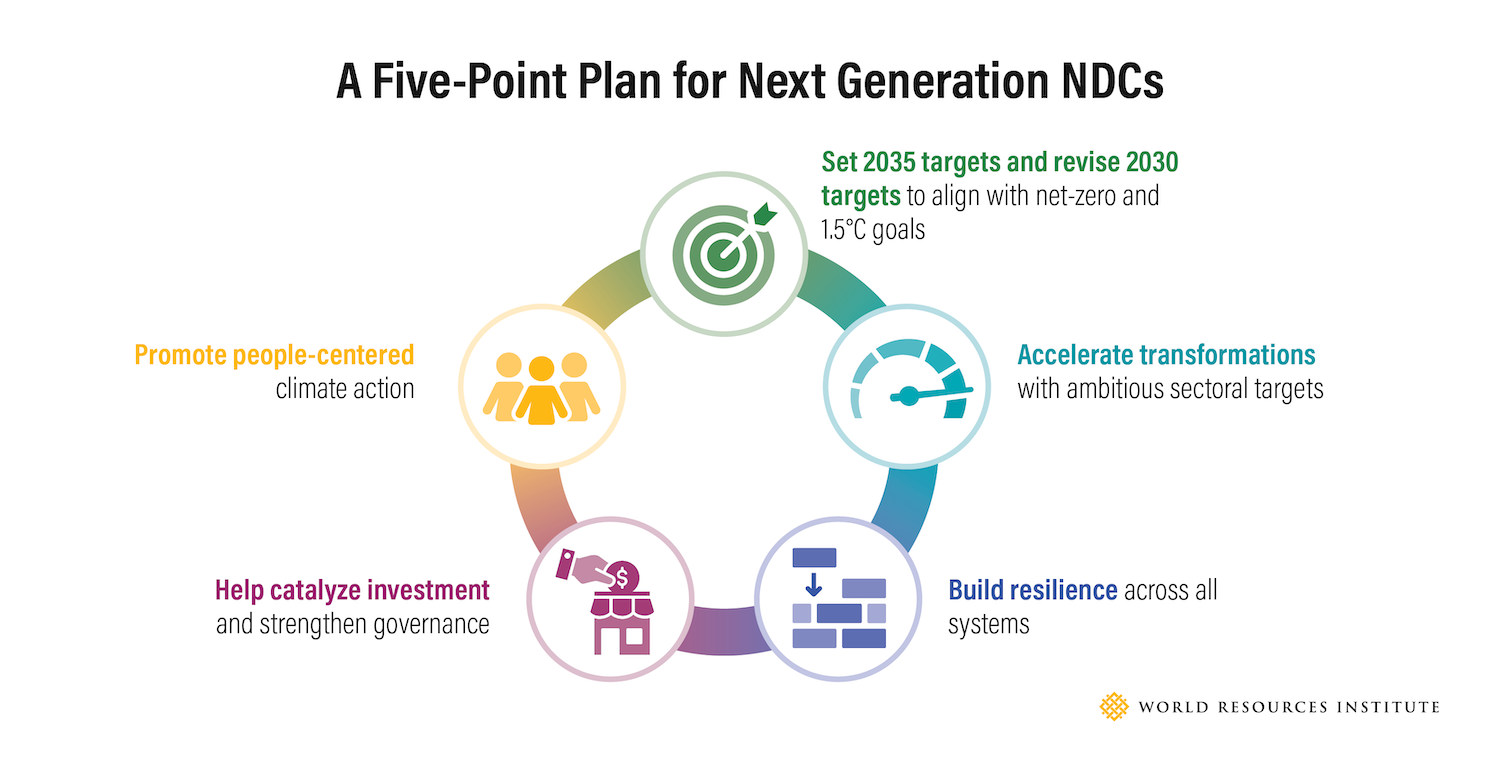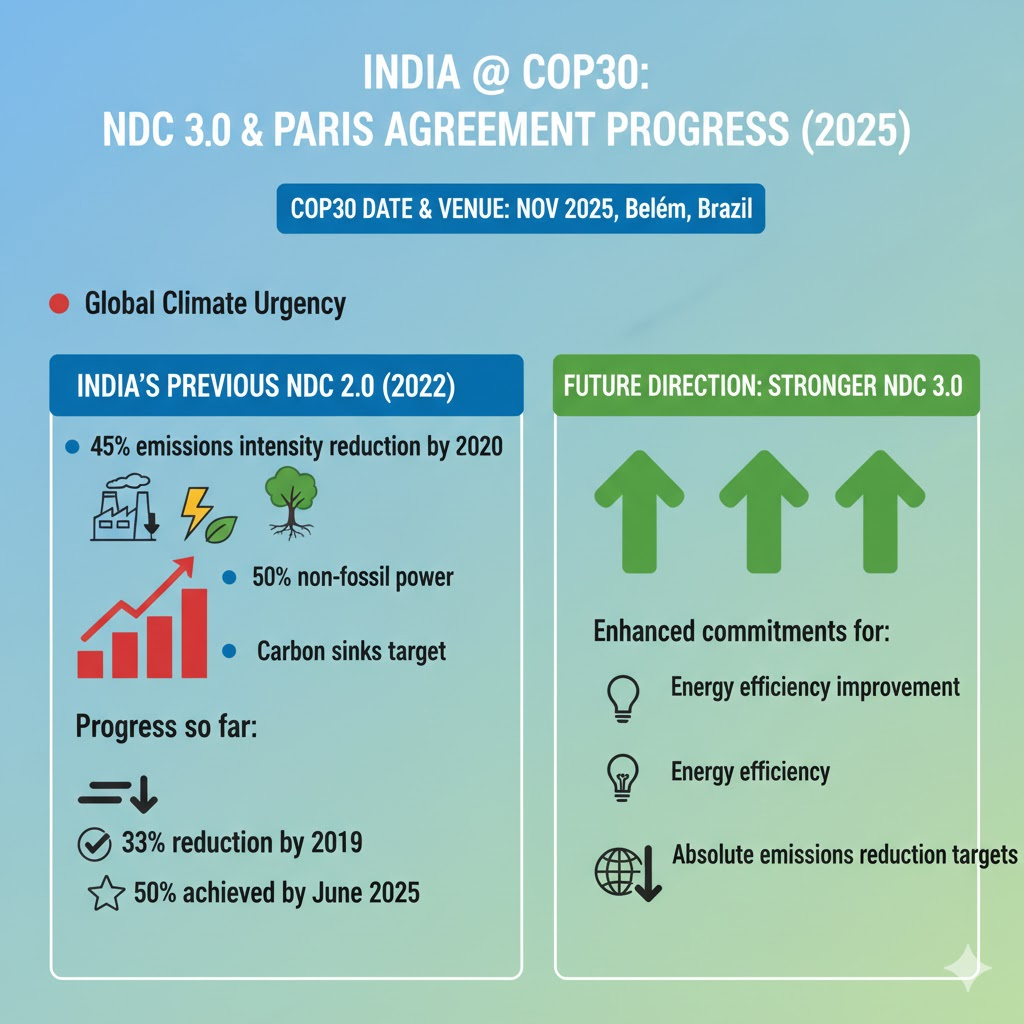Introduction:
As the world heads deeper into the decisive decade for climate action, India has signalled a key shift in its climate trajectory. At the UN COP30 Summit in Belém, Brazil, Environment Minister Bhupender Yadav announced that India will submit its revised Nationally Determined Contribution (NDC) for the 2031–2035 periods by December. This third round update, called “NDC 3.0,” comes at a time when it is urgent to improve global emissions.
-
- In the context of climate change, India has repeatedly made it clear that meaningful climate action by developing countries is possible only if they receive equitable financial support, affordable technologies and freedom from intellectual property restrictions that slow down the pace of climate transition.
- In the context of climate change, India has repeatedly made it clear that meaningful climate action by developing countries is possible only if they receive equitable financial support, affordable technologies and freedom from intellectual property restrictions that slow down the pace of climate transition.
India’s Position at COP30:
-
- India emphasised that implementation must be at the centre of global climate efforts. Climate action can succeed only when finance, technology, and capacity-building support are accessible, affordable, and free from restrictive intellectual property barriers. It urged the developed nations to provide “new, additional and concessional” climate finance at the scale of trillions of dollars.
- India also reiterated that developed countries should achieve net-zero well before their current timelines and fulfil their commitments under Article 9.1 of the Paris Agreement, which mandates financial support to developing nations. India highlighted three major developments in its domestic climate strategy:
- Launch of the Nuclear Mission
- Expansion of the Green Hydrogen Mission
- Upcoming release of the country’s first Biennial Transparency Report (BTR)
- Launch of the Nuclear Mission
- India’s emission intensity has already fallen by more than 36% since 2005, and non-fossil energy sources now make up over half of its installed electricity capacity—five years ahead of its 2030 target.
- India emphasised that implementation must be at the centre of global climate efforts. Climate action can succeed only when finance, technology, and capacity-building support are accessible, affordable, and free from restrictive intellectual property barriers. It urged the developed nations to provide “new, additional and concessional” climate finance at the scale of trillions of dollars.
Understanding Nationally Determined Contributions:
NDCs are the backbone of the Paris Agreement. They outline each country’s plan to reduce greenhouse gas emissions and strengthen climate adaptation. Every nation is expected to prepare, communicate, and maintain successive NDCs and pursue domestic mitigation measures to meet those goals.
Key Features of NDCs:
-
- Voluntary Commitments: Countries set their own emission-reduction and adaptation targets with no legal penalty for underperformance. However, they must transparently monitor and report progress.
- Five-Year Update Cycle: NDCs are submitted every five years, with each successive NDC expected to represent a “progression” and reflect the “highest possible ambition”.
- Equity and Development Considerations: The Paris Agreement recognises that developing countries like India need more time to peak emissions. Efforts must align with sustainable development and poverty-reduction priorities.
- Ratchet Mechanism: The Agreement believes that Global targets cannot be achieved in a single step and is built on a gradual increase in ambition, both individually and collectively (Article 4.11) to align with Article 2’s temperature goal and Article 4’s long-term emission-balance objective.
- Voluntary Commitments: Countries set their own emission-reduction and adaptation targets with no legal penalty for underperformance. However, they must transparently monitor and report progress.
Reporting and Monitoring:
NDCs are complemented by:
-
- Biennial Transparency Reports (BTRs)
- National Inventory Reports (NIRs)
- Data on climate policies, adaptation actions, finance needs and support received
- Updates on technology development and capacity-building requirements
- Biennial Transparency Reports (BTRs)
India’s Journey from INDC to Updated NDC:
India submitted its Intended NDC in 2015 with eight broad goals, of which three carried measurable 2030 targets:
-
- 40% of installed electricity capacity from non-fossil sources
- Emissions intensity reduction of 33–35% compared to 2005
- Creation of a 2.5–3 billion tonne carbon sink through forests and tree cover
- 40% of installed electricity capacity from non-fossil sources
Updated NDC Commitments (2022–2030):
-
- India revised its climate targets in 2022 and committed to:
- 45% reduction in emissions intensity of GDP by 2030
- Approximately 50% installed power capacity from non-fossil sources by 2030
- Strengthening the carbon sink goal through expanded forest and tree cover
- 45% reduction in emissions intensity of GDP by 2030
- India also introduced the concept of Lifestyle for Environment (LiFE), promoting sustainable consumption patterns rooted in conservation-oriented traditions.
- These updated goals reflect the principle of common but differentiated responsibilities (CBDR-RC) and India’s broader developmental priorities. They also provide a framework for cleaner energy transition across sectors such as transport, housing, waste management, and industry.
- India revised its climate targets in 2022 and committed to:
Significance of the Biennial Transparency Report:
-
- India will soon release its first BTR, an important requirement under the Paris Agreement. The report will include:
- National inventory of greenhouse gases
- Progress on NDC implementation
- Policies and measures across sectors
- Adaptation and climate-impact data
- Financial and technology support needs
- Gaps and areas needing improvement
- National inventory of greenhouse gases
- The BTR marks India’s entry into a more rigorous transparency and accountability framework.
- India will soon release its first BTR, an important requirement under the Paris Agreement. The report will include:
Domestic Measures Strengthening Climate Action:
-
- Clean Energy and Technology
- Rapid expansion of solar, wind, and hydropower capacity
- Production Linked Incentive schemes for renewable manufacturing
- Push for electric mobility and efficient appliances
- Expanding research and deployment of green hydrogen
- Rapid expansion of solar, wind, and hydropower capacity
- Forest and Landscape Restoration: A large-scale community movement has helped plant more than two billion saplings in just 16 months, reinforcing carbon sink creation and improving ecological resilience.
- Industrial Transition: Through platforms like the Leadership Group for Industry Transition (LeadIT), India is steering industries towards low-carbon pathways with support from global partners.
- Additional Sectoral Initiatives
- Energy efficiency programmes such as UJALA LED adoption
- Net-zero mission for Indian Railways
- Circular economy and waste-management reforms
- Water and agriculture adaptation programmes
- Energy efficiency programmes such as UJALA LED adoption
- India has financed much of its climate action through domestic resources. Yet, it maintains that scaled-up transition—especially in sectors like energy systems, infrastructure, and heavy industry—requires predictable, concessional international finance.
- Clean Energy and Technology
How Other Countries Are Approaching NDCs:
Over 100 countries have already submitted their updated NDCs, setting targets up to 2035. Many of these focus heavily on reducing fossil-fuel use.
Examples
-
- European Union: 55% net reduction in emissions by 2030 and up to 72.5% by 2035 (from 1990 levels).
- Brazil: 59–67% reduction from 2005 levels by 2035.
- China: Economy-wide net emission reduction of 7–10% from its “peak,” though it has not declared a specific peaking year.
- European Union: 55% net reduction in emissions by 2030 and up to 72.5% by 2035 (from 1990 levels).
Why NDCs Matter:
-
- Global Climate Control: They drive collective action to limit warming and reduce vulnerability.
- National Policy Direction: NDCs shape long-term energy, industrial, environmental, and economic planning.
- Coordination and Cooperation: NDCs enable countries to align climate strategies and engage meaningfully in global negotiations.
- Monitoring Progress: Regular reporting creates pressure to demonstrate measurable action.
- Access to Climate Finance: Countries with clear and implementable NDCs gain easier access to funds like the Green Climate Fund.
- Identifying Shortfalls: NDC processes also highlight delays, backsliding, or gaps in policy implementation.
- Global Climate Control: They drive collective action to limit warming and reduce vulnerability.
The Paris Agreement Framework:
The Paris Agreement, adopted in 2015 and in force since 2016, is the world’s most significant climate treaty. Its key goal is to keep global temperature rise “well below 2°C” and ideally within 1.5°C above pre-industrial levels.
Core Elements of the Agreement:
-
- Legally binding structure with flexibility for national circumstances
- NDC cycle for progressive ambition
- Global stocktake every five years
- Provision for climate finance, technology transfer, and capacity building
- Green Climate Fund to support developing nations
- Legally binding structure with flexibility for national circumstances
Conclusion:
India’s stance at COP30 captures a straightforward message: climate ambition must be matched by climate delivery. As the world enters the NDC 3.0 cycle, the coming decade will determine whether global efforts can truly steer the planet toward a safer, low-carbon future. As the Paris Agreement marks a decade, the next phase of India’s climate commitments will shape not only its domestic transition but also the broader global effort to keep 1.5°C alive.
| UPSC/PSC Main Question: Discuss the significance of Nationally Determined Contributions (NDCs) in achieving the goals of the Paris Agreement. What challenges do developing countries face in raising their NDC ambition? |









